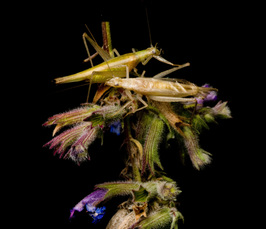Natasha Mhatre, Western University, London, Ontario, CA: An insect that uses a tool to sing and an amplifier to hear
Talk Natasha Mhatre, Seewiesen
- Datum: 21.01.2021
- Uhrzeit: 14:00 - 15:00
- Vortragende(r): Dr. Natasha Mhatre
- Western University, London, Ontario, CA
- Ort: Seewiesen
- Raum: Online
- Gastgeber: Dr. Holger Goerlitz
- Kontakt: hgoerlitz@orn.mpg.de

Crickets use sound to find each other space over which potential mates can sense each other is determined by the loudness of song and the sensitivity of the auditory system. According to the textbooks, this space is enhanced purely ‘passively’ through morphology and mechanical resonance. Song producting wings and females ears resonate at the same frequency enhancing the size of their acoustic space. But some crickets didn’t read the textbook. In this talk, I will present my research on Oecanthus henryi which is one such species. O. henryi is a tree cricket, and males of this species use an active behavioural strategy to make themselves louder. They manufacture an acoustic baffle, a tool that makes them louder. In fact, using a series of models and experiments, we showed that not only do they manufacture a tool, but they manufacture an optimal tool. Not to be outdone, we found that O. henryi females, have an active physiological amplification system in their ears. Using careful neurobiology we show that the amplifier doesn’t actually make them more sensitive than other crickets, as previously speculated. Rather, it allows them to change the frequency that they are sensitive to. What is even more remarkable is that this amplification is acheived through the activity of only a handful of motors protein. Both findings underline the poverty of our descriptions of invertebrate behaviour and biophysics, and point to a wealth of innovations yet to be discovered even among these ‘simple’ organisms.